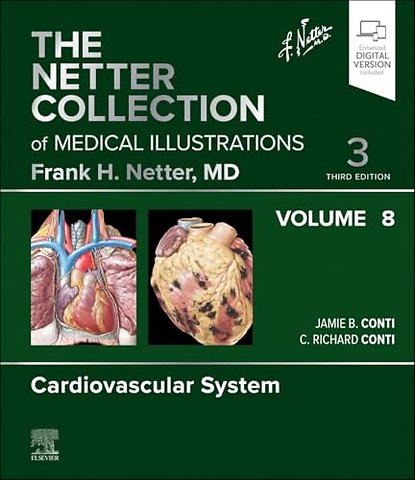SECTION 1 ANATOMY<br>1.1 Thorax: Lungs in Situ<br>1.2 Thorax: Heart in Situ<br>1.3 Thorax: Mediastinum<br>1.4 Thorax: Pericardial Sac<br>1.5 Exposure of the Heart: Anterior Exposure<br>1.6 Exposure of the Heart: Base and Diaphragmatic Surfaces<br>1.7 Atria and Ventricles: Right Atrium and Right Ventricle<br>1.8 Atria and Ventricles: Left Atrium and Left Ventricle<br>1.9 Atria and Ventricles: Atria, Ventricles, and Interventricular Septum<br>1.10 Valves: Cardiac Valves Open and Closed<br>1.11 Valves: Valves and Fibrous Skeleton of Heart<br>1.12 Specialized Conduction System of Heart<br>1.13 Coronary Arteries and Cardiac Veins: Sternocostal and Diaphragmatic Surfaces<br>1.14 Coronary Arteries and Cardiac Veins: Arteriovenous Variations<br>1.15 Innervation of Heart: Nerves of Heart<br>1.16 Innervation of Heart: Schema of Innervation<br><br>SECTION 2 PHYSIOLOGY<br>2.1 Cardiovascular Examination: Cardiac Cycle<br>2.2 Cardiovascular Examination: Important Components<br>2.3 Cardiovascular Examination: Positions for Cardiac Auscultation<br>2.4 Cardiovascular Examination: Areas of Cardiac Auscultation<br>2.5 Cardiovascular Examination: Murmurs<br>2.6 Neural and Humoral Regulation of Cardiac Function<br>2.7 Physiologic Changes During Pregnancy<br>2.8 Cardiac Catheterization: Vascular Access<br>2.9 Cardiac Catheterization: Left-Sided Heart Catheterization<br>2.10 Cardiac Catheterization: Normal Saturations (O2) and Pressure<br>2.11 Cardiac Catheterization: Examples of O2 and Pressure Findings and Pressure Tracings in Heart Diseases<br>2.12 Cardiac Catheterization: Normal Cardiac Blood Flow During Inspiration and Expiration<br>2.13 Specialized Conduction System: Physiology<br>2.14 Specialized Conduction System: Electrical Activity of the Heart<br>2.15 Electrocardiogram<br>2.16 Electrocardiogram (Continued)<br>2.17 Progression of Depolarization<br>2.18 End of Depolarization Followed by Repolarization<br>2.19 Axis Deviation in Normal Electrocardiogram<br>2.20 Atrial Enlargement<br>2.21 Ventricular Hypertrophy<br>2.22 Bundle Branch Block<br>2.23 Wolff-Parkinson-White Syndrome<br>2.24 Atrioventricular Nodal Reentrant Tachycardia<br>2.25 Sinus and Atrial Arrhythmias<br>2.26 Premature Contraction<br>2.27 Sinus Arrest, Sinus Block, and Atrioventricular Block<br>2.28 Tachycardia, Fibrillation, and Atrial Flutter<br>2.29 Sudden Cardiac Death<br>2.30 Effect of Digitalis and Calcium/Potassium Levels on Electrocardiogram<br>2.31 Cardiac Pacing: Dual Chamber and Biventricular<br>2.32 Cardiac Pacing: Leadless Technology and Subcutaneous Implantable Cardioverter Defibrillators<br><br>SECTION 3 IMAGING<br>3.1 Radiology: Frontal Projection<br>3.2 Radiology: Right Anterior Oblique Projection<br>3.3 Radiology: Left Anterior Oblique Projection<br>3.4 Radiology: Lateral Projection<br>3.5 Angiocardiography: Anteroposterior Projection of Right-Sided Heart Structures<br>3.6 Angiocardiography: Lateral Projection of RightSided Heart Structures<br>3.7 Angiocardiography: Anteroposterior Projection of Left-Sided Heart Structures<br>3.8 Angiocardiography: Lateral Projection of Left-Sided Heart Structures<br>3.9 Catheter-Based Coronary Angiography: Right Coronary Artery<br>3.10 Catheter-Based Coronary Angiography: Left Coronary Artery<br>3.11 Intravascular Ultrasound<br>3.12 Transthoracic Cardiac Ultrasound<br>3.13 Doppler Echocardiography<br>3.14 Transesophageal Echocardiography<br>3.15 Intracardiac Echocardiography<br>3.16 Optical Coherence Tomography<br>3.17 Exercise and Contrast Echocardiography<br>3.18 Myocardial Perfusion Imaging<br>3.19 Ventriculography<br>3.20 Computed Tomographic Angiography: Cardiac Cycle and Calcium Contrast Studies<br>3.21 Computed Tomographic Angiography: Interpretation (Continued)<br>3.22 Radiation Dose Concerns<br>3.23 Cardiac Magnetic Resonance Imaging<br>3.24 Cardiac Magnetic Resonance Imaging (Continued)<br><br>SECTION 4 EMBRYOLOGY<br>4.1 Early Embryonic Development<br>4.2 Early Intraembryonic Vasculogenesis<br>4.3 Formation of the Heart Tube: One-Somite and Two-Somite Stages<br>4.4 Formation of the Heart Tube: Four-Somite and Seven-Somite Stages<br>4.5 Formation of the Heart Loop: 10-Somite and 14-Somite Stages<br>4.6 Formation of the Heart Loop: 20-Somite Stage<br>4.7 Formation of Cardiac Septa: Development of Ventricles and Atrioventricular Valves<br>4.8 Formation of Cardiac Septa: 27 and 29 Days<br>4.9 Formation of Cardiac Septa: 31 and 33 Days<br>4.10 Formation of Cardiac Septa: 37 and 55 Days<br>4.11 Formation of Cardiac Septa: Heart Tube Derivatives<br>4.12 Formation of Cardiac Septa: Partitioning of the Heart Tube: Atrial Septation<br>4.13 Formation of Cardiac Septa: Embryonic Origins, Right and Left Sides<br>4.14 Development of Major Blood Vessels: 3, 4, and 10 mm<br>4.15 Development of Major Blood Vessels: 14 mm, 17 mm, and at Term<br>4.16 Development of Major Blood Vessels: 4, 10, and 14 mm<br>4.17 Development of Major Blood Vessels: 17 mm, 24 mm, and at Term<br>4.18 Fetal Circulation and Changes at Birth<br>4.19 Three Early Vascular Systems<br><br>SECTION 5 CONGENITAL HEART DISEASE<br>5.1 Physical Examination<br>5.2 Anomalies of the Great Systemic Veins<br>5.3 Total Anomalous Pulmonary Venous Connection<br>5.4 Surgery for Anomalous Pulmonary Venous Return<br>5.5 Anomalies of the Atria<br>5.6 Defects of the Atrial Septum: Anatomy<br>5.7 Defects of the Atrial Septum: Surgery<br>5.8 Defects of the Atrial Septum: Septal Occluder Device<br>5.9 Endocardial Cushion Defects: Anatomy and Embryology<br>5.10 Endocardial Cushion Defects: Surgery for Ostium Primum and Cleft Mitral Valve<br>5.11 Anomalies of Tricuspid Valve: Tricuspid Atresia<br>5.12 Anomalies of Tricuspid Valve: Glenn Surgery for Tricuspid Atresia<br>5.13 Anomalies of Tricuspid Valve: Ebstein Anomaly<br>5.14 Anomalies of Tricuspid Valve: Types of Ebstein Anomaly<br>5.15 Anomalies of the Ventricular Septum<br>5.16 Anomalies of the Ventricular Septum (Continued)<br>5.17 Anomalies of the Ventricular Septum: Transatrial Repair of Ventricular Septal Defect<br>5.18 Anomalies of Right Ventricular Outflow Tract: Tetralogy of Fallot<br>5.19 Anomalies of Right Ventricular Outflow Tract: Pathophysiology and Blalock-Taussig Operation for Tetralogy of Fallot<br>5.20 Anomalies of Right Ventricular Outflow Tract: Corrective Operation for Tetralogy of Fallot<br>5.21 Anomalies of Right Ventricular Outflow Tract: Repair of Tetralogy of Fallot<br>5.22 Anomalies of Right Ventricular Outflow Tract: Eisenmenger Complex and Double-Outlet Right Ventricle<br>5.23 Anomalies of Right Ventricular Outflow Tract: Pulmonary Valvular Stenosis and Atresia<br>5.24 Anomalies of Left Ventricular Outflow Tract: Aortic Atresia, Bicuspid Aortic Valve, and Aortic Valvular Stenosis<br>5.25 Anomalies of Left Ventricular Outflow Tract: Fibrous and Idiopathic Hypertrophic Subaortic Stenoses<br>5.26 Anomalies of Left Ventricular Outflow Tract: Norwood Correction of Hypoplastic Left Heart Syndrome<br>5.27 Transposition of the Great Vessels<br>5.28 Transposition of the Great Vessels: Mustard and Blalock-Hanlon Operations<br>5.29 Transposition of the Great Vessels: Balloon Atrial Septostomy and Arterial Repair of Transposition of the Great Arteries<br>5.30 Transposition of the Great Vessels with Inversion of Ventricles<br>5.31 Anomalies of the Truncus Septum<br>5.32 Anomalous Left Coronary Artery and Aneurysm of Sinus of Valsalva<br>5.33 Anomalous Coronary Arteries Seen in Adult Patients<br>5.34 Anomalies of Aortic Arch System: Patent Ductus Arteriosus<br>5.35 Anomalies of Aortic Arch System: Aberrant Right Subclavian Artery<br>5.36 Anomalies of Aortic Arch System: Double Aortic Arch and Right Aortic Arch Anomalies<br>5.37 Anomalies of Aortic Arch System: Anomalous Origins of the Pulmonary Artery<br>5.38 Anomalies of the Aortic Arch System: Anatomic Features of Aortic Coarctation in Older Children and Neonates<br>5.39 Anomalies of Aortic Arch System: Coarctation of Aorta<br>5.40 Endocardial Fibroelastosis and Glycogen Storage Disease<br><br>SECTION 6 ACQUIRED HEART DISEASE<br>Ischemic Heart Disease<br>6.1 Structure of Coronary Arteries<br>6.2 Pathogenesis of Atherosclerosis<br>6.3 Risk Factors in Etiology of Atherosclerosis<br>6.4 Pathologic Changes in Coronary Artery Disease<br>6.5 End Organ Damage by Vascular Disease<br>6.6 Unstable Plaque Formation<br>6.7 Angiogenesis and Arteriogenesis<br>Chronic Angina<br>6.8 Overview of Myocardial Ischemia<br>6.9 Angina Pectoris<br>6.10 Coronary Artery Spasm<br>6.11 Detection of Myocardial Ischemia<br>6.12 Degree of Flow-Limiting Stenoses<br>6.13 Left-Sided Heart Angiography<br>6.14 Fractional Flow Reserve<br>6.15 Stent Deployment<br>6.16 Rotational Atherectomy and Distal Protection Device<br>Acute Coronary Syndromes<br>6.17 Pathophysiology of Acute Coronary Syndromes<br>6.18 Myocardial Infarction: Changes in the Heart<br>6.19 Myocardial Infarction: Changes in the Heart (Continued)<br>6.20 Myocardial Infarction: Changes in the Heart (Continued)<br>6.21 Myocardial Infarction: Changes in the Heart (Continued)<br>6.22 Manifestations of Myocardial Infarction: First Day to Several Weeks<br>6.23 Manifestations of Myocardial Infarction: Effects of Myocardial Ischemia, Injury, and Infarction on ECG<br>6.24 Recanalization of Occluded Coronary Artery in Acute Myocardial Infarction<br>6.25 Intraaortic Balloon Counterpulsation<br>Acute Rheumatic Fever and Rheumatic Heart Disease<br>6.26 Sydenham Chorea: Infection, Disease Course, and Heart Muscle<br>6.27 Sydenham Chorea: Noncardiac Manifestations<br>6.28 Rheumatic Heart Disease: Acute Pericarditis and Myocarditis<br>6.29 Rheumatic Heart Disease: Acute Valvular Involvement<br>6.30 Rheumatic Heart Disease: Residual Changes of Acute Rheumatic Carditis<br>6.31 Mitral Stenosis: Pathologic Anatomy<br>6.32 Mitral Stenosis: Pathophysiology and Clinical Aspects<br>6.33 Mitral Stenosis: Secondary Anatomic Effects<br>6.34 Mitral Stenosis: Secondary Pulmonary Effects<br>6.35 Mitral Stenosis: Thromboembolic Complications<br>6.36 Mitral Stenosis: Thromboembolic Complications: Principal Sites of Embolism from Left Atrial Thrombosis<br>6.37 Mitral Stenosis: Thromboembolic Complications: Mitral Balloon Valvuloplasty<br>6.38 Mitral Regurgitation<br>6.39 Mitral Regurgitation: Pathophysiology and Clinical Aspects<br>6.40 Mitral Valve Clip<br>6.41 Mitral Valve Repair<br>6.42 Mitral Valve Prolapse<br>Aortic and Vascular Disease<br>6.43 Aortic Stenosis: Rheumatic and Nonrheumatic Causes<br>6.44 Aortic Stenosis: Rheumatic and Nonrheumatic Causes (Continued)<br>6.45 Aortic Regurgitation: Pathology<br>6.46 Aortic Regurgitation: Pathology (Continued)<br>6.47 Transcutaneous Aortic Valve Replacement<br>6.48 Cystic Medial Necrosis of Aorta<br>6.49 Cystic Medial Necrosis of Aorta: Surgical Management<br>6.50 Syphilitic Aortic Disease<br>Prosthetic Valve Surgery<br>6.51 First Generation of Synthetic Prosthetic Valves<br>6.52 Second Generation of Synthetic Prosthetic Valves and Biologic Valves<br>6.53 Mitral Valve Replacement<br>6.54 Aortic Valve Replacement<br>6.55 Excision of Aortic Aneurysm and Replacement of Aortic Valve for Cystic Medial Necrosis<br>6.56 Multiple Valve Replacement<br>6.57 Insertion of Trileaflet Aortic Valve<br>6.58 Aortic Valve Biologic Grafts<br>Tricuspid Valve Disease<br>6.59 Tricuspid Stenosis and Regurgitation and Multivalvular Disease<br>6.60 Tricuspid Stenosis and/or Insufficiency<br>Amyloidosis, Myocarditis, and Other Cardiomyopathies<br>6.61 Amyloidosis<br>6.62 Septic Myocarditis<br>6.63 Diphtheritic and Viral Myocarditis<br>6.64 Myocarditis in Sarcoidosis and Scleroderma<br>6.65 Idiopathic Myocarditis<br>6.66 Endomyocardial Fibrosis<br>6.67 Loeffler Endocarditis<br>6.68 Becker Disease<br>6.69 Beriberi<br>6.70 Cardiomyopathies<br>6.71 Acquired Immunodeficiency Syndrome and the Heart<br>6.72 Substance Abuse and the Heart<br>Pericardial Disease<br>6.73 Presentation and Treatment of Pericarditis<br>6.74 Etiologies of Pericarditis<br>6.75 Constrictive Pericarditis<br>Acute and Chronic Cor Pulmonale and Pulmonary Embolism<br>6.76 Massive Embolization<br>6.77 Embolism of Lesser Degree Without Infarction<br>6.78 Lesions That May Cause Pulmonary Hypertension and Chronic Cor Pulmonale<br>6.79 Chronic Cor Pulmonale<br>6.80 Deep Vein Thrombosis<br>Infective Endocarditis<br>6.81 Infective Endocarditis: Portals of Entry and Predisposing Lesions<br>6.82 Early Lesions of Infective Endocarditis<br>6.83 Advanced Lesions of Infective Endocarditis<br>6.84 Right-Sided Heart Involvement in Infective Endocarditis<br>6.85 Cardiac Sequelae of Infective Endocarditis<br>6.86 Mycotic Aneurysms and Emboli in the Heart<br>6.87 Remote Embolic Effects of Infective Endocarditis<br>6.88 Nonbacterial Thrombotic (Marantic) Endocarditis<br>Cardiopulmonary Resuscitation and Hypothermia Therapy<br>6.89 External Cardiopulmonary Resuscitation<br>6.90 Internal Cardiac Massage<br>6.91 Defibrillation<br>Connective Tissue Disease<br>6.92 Rheumatoid Arthritis<br>6.93 Ankylosing Spondylitis<br>6.94 Polymyositis and Dermatomyositis<br>6.95 Scleroderma (Progressive Systemic Sclerosis)<br>6.96 Systemic Lupus Erythematosus<br>Endocrine Disorders and Cardiac Disease<br>6.97 Acromegaly<br>6.98 Hyperthyroidism: Thyrotoxicosis<br>6.99 Hypothyroidism: Myxedema<br>6.100 Cushing Syndrome<br>6.101 Primary Hyperaldosteronism: Mineralocorticoid Hypertension<br>6.102 Pheochromocytoma<br>Heart Tumors<br>6.103 Myxoma and Rhabdomyoma<br>6.104 Metastatic Tumors of the Heart<br>Hypertension<br>6.105 Interdependent and Interacting Factors in Blood Pressure Regulation<br>6.106 Etiology of Hypertension<br>6.107 Renin–Angiotensin System<br>6.108 Wave Reflection and Isolated Systolic Hypertension<br>6.109 Causes of Secondary Hypertension Possibly Amenable to Surgery<br>6.110 Retinal Changes in Hypertension<br>6.111 Occlusive Disease of Main Renal Artery<br>6.112 Occlusive Disease of Main Renal Artery (Continued)<br>6.113 Kidneys and Hypertension<br>6.114 Heart Disease in Hypertension<br>6.115 Heart Disease in Hypertension (Continued)<br>6.116 Hypertension and Congestive Heart Failure Disease<br>6.117 Obstructive Sleep Apnea and Hypertension<br>Neuromuscular Disorders<br>6.118 Duchenne Muscular Dystrophy<br>6.119 Myotonic Dystrophy<br>6.120 Friedreich Ataxia<br>6.121 Disorders of Potassium Metabolism<br>Penetrating and Nonpenetrating Heart Trauma<br>6.122 Cardiac Tamponade in Penetrating Heart Wounds<br>6.123 Relative Distribution of Penetrating Heart Wounds<br>6.124 Variable Course of Penetrating Heart Wounds<br>6.125 Thoracotomy and Cardiorrhaphy<br>6.126 Thoracotomy and Cardiorrhaphy (Continued)<br>6.127 Nonpenetrating Heart Wounds: Pathogenesis and Variable Course of Cardiac Contusion<br>6.128 Nonpenetrating Heart Wounds: Myocardial Rupture and Valvular Injuries<br>6.129 Nonpenetrating Heart Wounds: Mechanism of Sudden Cardiac Death in Commotio Cordis<br>Percutaneous Intervention Procedures<br>6.130 Percutaneous Approaches to Reduce Cerebral Emboli<br>6.131 Cerebrovascular Emboli Protection Device<br>6.132 Interventional Approaches to Peripheral Arterial Disease<br>Heart Failure<br>6.133 Right-Sided and Left-Sided Heart Failure and Systemic Congestion: Physical Examination<br>6.134 Right-Sided and Left-Sided Heart Failure in Dilated Cardiomyopathy and Pulmonary Congestion<br>6.135 Pulmonary Congestion or Edema of Cardiac and Other Origins<br>6.136 Causes and Pathogenesis of Pulmonary Edema<br>6.137 Cardiac Origins of Peripheral or Systemic Congestion or Edema<br>6.138 Therapy for Pulmonary Edema and Paroxysmal Dyspnea<br>6.139 Biventricular Pacing and Intracardiac Defibrillator: Benefit of Biventricular Pacing<br>6.140 Biventricular Pacing and Implantable Cardiac Defibrillator<br>6.141 Diastolic Heart Failure<br>6.142 Heart Transplantation: Orthotopic Biatrial Cardiac Transplantation<br>6.143 Heart Transplantation: Bicaval Cardiac Transplantation<br>6.144 Heart Transplantation: HeartMate XVE and II Left Ventricular Assist Systems<br>Sudden Cardiac Death in Young Athletes<br>6.145 Sudden Death in Hypertrophic Cardiomyopathy<br>Syncope<br>6.146 Management of Syncope<br>Parasitic Disease and the Heart<br>6.147 Trichinosis (Parasitic Heart Disease)<br>6.148 Chagas Disease (Trypanosomiasis)<br>6.149 Amebic Pericarditis<br>6.150 Echinococcus Infection and Hydatid Pericarditis

